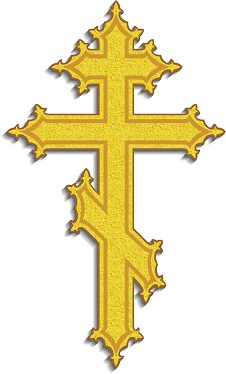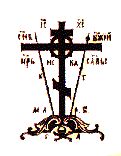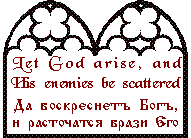
The Saint John of Kronstadt Centre was established in New York City in 1998. It is a prayer, study, and research centre for the Orthodox-Catholic Church of America, and it is the administrative centre for the Diocese of New York, under the omophor of the OCCA Bishop in New York.
Father John of Kronstadt is often known as the Orthodox conscience for the twentieth century. Although his initial impulse was to enter the missionary field in Siberia or Alaska, Saint John found his destiny among the simple outcasts, poor and homeless of Kronstadt, where he served at Saint Andrew's Cathedral. The great man of God was called home to the Lord on 20 December 1908, and was glorified in 1964.
"We glorify you, O holy and righteous father John, and we honor your holy memory, for you pray with us and intercede for us to Christ our God."

"Having set aside earthly concerns, with one voice let us praise the splendid beacon of Russia and of the whole world, the good shepherd, the priest John. He gave us the model of authentic life in Christ; he who on earth was on fire with the spirit of prayer, and who received from the Lord the gift of healing. Through his prayers may Christ strenghen our faith and perseverance."
"Making room for everyone in your pastoral heart, and deeply wounded by the wounds inflicted by poverty, injustice and oppression, you called all people by your words and writing to build a house of industry, a refuge and safe space for the poor in your care. Your care and love for them on earth was a foreshadowing of your intercession now for us all in heaven."
"O great Saint John, pray for us and guide us amid all the circumstances of this life, that with your guidance, prayers, and protection we may hope to be granted admission to the Kingdom of Heaven."
Interested enquirers are invited to contact us with respect to pastoral and parochial services, personal spiritual direction and consultation, or classes, seminars, retreats, or other presentations. Click on the link on this page or go to http://www.saintjohnofkronstadt.faithweb.com. On this page we offer general information about the phenomenon of Western Rite Orthodoxy and the Orthodox-Catholic Church of America. For more specific information on certain of these, you may click on the links below, or you may email me directly.
Right Revd. Bishop Elizabeth
Diocese of New York
bishop-elizabeth@outlook.com
 For the first millennium of Christianity, all were Orthodox. In the Christian West, worship tended to reflect the culture and traditions of the Latin expression of the Roman empire, as well as those of the local regions to which the Church had come. And so therefore, there were the Mozarabic, Celtic, Ambrosian, and Gallican liturgies in addition to that of Rome: the Gregorian. Furthermore, among the religious orders of the Roman patriarchate, the Carthusians, Cistercians, Premonstratensians, Carmelites, Dominicans, and Gilbertines all had their own specific traditional rites. It is popular, but fundamentally erroneous, to describe this liturgy as the "Tridentine" mass, for very much of the text pre-dates the Roman council of Trent by several centuries. While the Tridentine council contributed a numerous innovations and approved the additions and accretions of the foregoing thousand years, it must be said that the central texts of the rite date from the late sixth century. As early as AD 747, in fact, the Orthodox local synod of Cloveshoo decreed that "the Roman Rite of Saint Gregory the Great shall be the sole proper rite for English-speaking Christians."
For the first millennium of Christianity, all were Orthodox. In the Christian West, worship tended to reflect the culture and traditions of the Latin expression of the Roman empire, as well as those of the local regions to which the Church had come. And so therefore, there were the Mozarabic, Celtic, Ambrosian, and Gallican liturgies in addition to that of Rome: the Gregorian. Furthermore, among the religious orders of the Roman patriarchate, the Carthusians, Cistercians, Premonstratensians, Carmelites, Dominicans, and Gilbertines all had their own specific traditional rites. It is popular, but fundamentally erroneous, to describe this liturgy as the "Tridentine" mass, for very much of the text pre-dates the Roman council of Trent by several centuries. While the Tridentine council contributed a numerous innovations and approved the additions and accretions of the foregoing thousand years, it must be said that the central texts of the rite date from the late sixth century. As early as AD 747, in fact, the Orthodox local synod of Cloveshoo decreed that "the Roman Rite of Saint Gregory the Great shall be the sole proper rite for English-speaking Christians."
Following the defection of the Roman patriarchate in the 11th century, the Western rite was absent from Orthodoxy until the late 19th Century, when the Russian Synod responded to the 1869 petition of the Rev. Dr. John Joseph Overbeck and others, and restored the Western Rite for the use of Western converts to Holy Orthodoxy in the Russian jurisdiction. The Latin text of the newly restored rite (substantially that same Gregorian rite mentioned above, with several corrrections and emendations to ensure the proper articulation of Orthodoxy in public worship), with an English translation, was first published in 1871. [See Liturgia Missae Orthodoxo-Catholicae Occidentalis, Halle,1871, and also Catholic Orthodoxy and Anglo-Catholicism, London 1866.] Later, in 1888, a Western rite faith community in Ceylon was erected by the Syrian Orthodox Antiochene Patriarchate, and it was this church that enabled the establishment of the Orthodox-Catholic Church of America.
 Originally under the patronage of the North American diocese of the Russian patriarchate, in 1892 the community was received by the Antiochene patriarchate's Western Rite archbishopric in Ceylon and established as the Metropolitan Archdiocese of America. Autonomous since 1910, the OCCA is one of the oldest Orthodox Western Rite entities in North America.
Originally under the patronage of the North American diocese of the Russian patriarchate, in 1892 the community was received by the Antiochene patriarchate's Western Rite archbishopric in Ceylon and established as the Metropolitan Archdiocese of America. Autonomous since 1910, the OCCA is one of the oldest Orthodox Western Rite entities in North America.
Because liturgy is always pre-eminently the work of God’s people, it is no less alive than those whose work it is. Over time, however, certain conventions and habits of language and syntax become routinized . . . the modern author Annie Dillard metaphorically suggests that these customary ways of praying amount to “certain words that people have successfully addressed to God without getting killed,” and it is perhaps for this reason among many others (as, for example, love for the words and love for tradition) that liturgical change and evolution can often be seen as revolutionary, counter-cultural, and subversive.
Yet within the traditions, liturgical diversity remains normative. In the Christian East, it is customary to refer to the liturgies of Saints John Chrysostom, Basil, and James as if they alone were the proper fields within which we might address the living God. The traditions associated with the many cultures to which Christianity has migrated, as for example the Armenian, Assyrian, Melkite, Coptic, Malankara, and Maronite, demonstrate eloquently how the one unchanged faith is expressed according to varying cultural norms. Enlivened by the same spirit of accommodation and missionary zeal, in our time, and particularly in North America, several jurisdictions have taken the bold step of conducting worship in English rather than in the language of their ancestors.
In the Christian West, the analogous diversity exists in the ancient rites of such religious orders as the Carthusians, Dominicans, and Cistercians, as well as the local usages of the various dioceses, of which that of Salisbury is perhaps one of the most well-known. In the West also we find the Mozarabic, Celtic and Gallican rites growing out of the devotion and faith of specific cultures and peoples. Though the actions of the Roman council of Trent made for the suppression of many of these local and regional rites, the texts remain to show the deep faith of these people.
Since the 1880’s, the Orthodox-Catholic Church of America has supported the recovery and loving restoration of some of these liturgical “museum pieces,” as well as the reconstruction and re-interpretation of old rites for use in the mission field of North America. Moreover, recognizing the dynamic tension between accommodation of culture and preservation of tradition, the OCCA has carefully re-translated and revised rite and ceremonial to enable meaningful, intentional, conscious worship of the one Triune God.
As we move confidently into the third millennium of Christianity, we certainly will not turn our backs on the work of our spiritual ancestors; rather, we will build on their work to bring a fresh vision. In light of the Orthodox genius for the accommodation to new cultures and the welcoming of enquirers and converts, we would see the venerable traditions anew and bring it to God’s people again; we would worship God according to our “new world” North American cultural world-view; we would show by our words and works that our God lives and that our God -- the ubiquitous One in Whom we live and move and have our being -- is here in this time, in this place, in this culture, for everyone.
In the mid-1990's, the Orthodox-Catholic Church of America, with the prayerful action of the Holy Synod and the consent of the clergy, removed the barriers and impediments to holy orders based on gender. The decision, while significant, was no easy one; and it was certainly not without controversy, in light of Orthodox Canon Law, tradition, and the consensus among most Orthodox hierarchs to the contrary. Inasmuch as there are still very few Orthodox jurisdictions that ordain women, the matter is by no means settled and the discussion continues in and out of the Church. While a final decision for worldwide Orthodoxy will likely rest with nothing less than an ecumenical council, it seems that it may be useful here to provide a short preliminary introductory discussion of that issue and the OCCA's position. Please click on the link below for A Commentary on Women in Priesthood.

Further Information
Orthodox Catholic Church of America National Web Site
Crosswood Monastery and Chancery Office
Saint John's Community - NYC
A Commentary on Women in Priesthood
Pastoral and Parish Work
New Paradigms of Ministry in the Third Millennium
The Paradosis Missal Project
Other Links